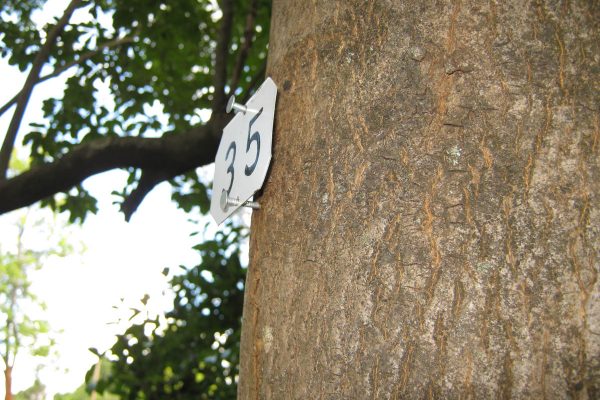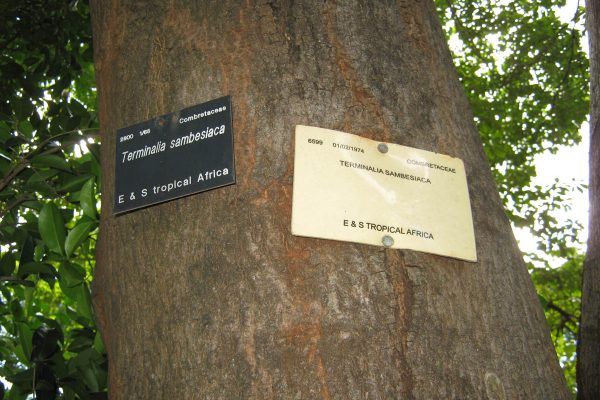Tree Labelling
The tree label above is from a private tree labeling exercise undertaken at Hippo Pools Wilderness Camp located in Umfurudzi on the Mazowe River.
The Tree Society members have been helping the National Botanical Garden staff to label their trees – these labels were given by the Diplomatic Spouses Association in Harare. They have also been helping the staff at Ewanrigg Botanic Gardens to name trees there, but without a planting plan it has been more difficult, especially finding names for the exotic trees. In addition, trees in other locations have also been labelled.
They have learnt that because of continuing tree name changes (which keeps the taxonomists employed), the easiest way of labelling a tree / bush is to attach a number to it and then provide a list with the correct names against each number. On the list, all the details pertaining to that number can be shown and as names change so the list is amended accordingly. They have also learnt that even large trees grow and expand their girth quite considerably so that annual maintenance is required to cater for this expansion. They therefore start by nailing a label onto a tree but not hitting the nail all the way down until it reaches the bark, so that about 15cm of nail is left still sticking out. After every season of growth, nails are pulled out enough to provide more growing space. On trees / bushes that have stems / branches that are too thin to take a nail, a label is secured loosely onto a suitable branch with wire or is placed on a peg. The tree list, which can be bought from the gate / reception of each of the sites, has such details as: number of tree, botanical name, common English and African names, etc. as well as the GPS co-ordinates of a good specimen of the tree in that particular garden. At the back of the listing, there is an index with all the names on the list but with many more common names, old botanical names etc. If anyone wants to know whether or not a certain tree exists on that site, all they have to do is look it up in the index.
On each listing the following message or words to that effect appear: “The Tree Society of Zimbabwe has put together this tree listing. Although indigenous trees are readily identified, there is a problem in identifying exotic trees. If you live elsewhere in the world, what we term an exotic tree may very well be an indigenous tree to you. If you recognize any tree that has not been numbered or is mislabeled, please advise the person at the gate/reception and if possible supply the GPS co-ordinates for the tree.”
Mukuvisi Woodlands
The Mukuvisi Woodlands has had its trees labelled several times (that is within the Interpretive Area outside the game fence) but somehow the labels have not lasted for whatever reason – some remnants of the old labelling systems can still be seen. A few years ago, it was decided to label the trees again, not with a label as such but by using a number that was painted onto the bark of the tree, which would prevent theft. A pamphlet was printed which contained information on the numbered trees, such as Botanical names, old Botanical names, common English as well as common African names, an index etc. – it even included the uses of these trees! The problem with this system is that some trees shed their outer bark and therefore lose the painted numbers. Also, as the tree grows the girth increases and expansion cracks distort the number. Today, most of these numbers are still in existence but have been complemented by discs that have the information painted on them.
Recently another exercise was completed using numbers painted on Chromadek discs which were secured to the trees. It was amazing to note just how many trees have been lost in the last five years!
Presently there are 142 numbered trees, some of them being exotic species. If you want to see Acacias, Mukuvisi Woodlands is a good place to start as there are more than a dozen different species there.
National Botanic Garden
Labeling commenced in 2018 in the National Botanic Garden and the first Tree List of 300 pamphlet became available at the entrance to the car park. This list was sent to all Tree Society of Zimbabwe members. An additional 100+ trees have been labelled, however there are quite a few unknown trees in this range. As more trees are identified, new listings will become available. There are many exotic trees in this location.
Ewanrigg Botanical Gardens
Just over 200 trees / bushes in Ewanrigg Botanical Gardens have been identified so far. The indigenous trees have all been labelled but there are many unknown exotic trees that still need to be identified. The list is now available at the entrance gate.
Lasting Impressions
The first tree labelling at Lasting Impressions, a site just beyond Kadoma near Claw Dam, was done in October 2017. Further labelling took place by Mark Hyde and Tony Alegria in May 2018. A total of 102 trees have been identified so far and the list is unlikely to grow much more. Trees were identified in the “Camp” – were the “A” frame dormitories, ablution blocks and a large thatched all purpose function building are located on top of a hill. Trees were also identified on the top of a hill and sides along its access road – this hill represents the highest point on the property and is called “Mount Everest”. Trees were also identified along the roads from the entrance gate to the “Camp” and all the way to the base of “Mount Everest”. The lists now need to be completed with the biggish issue being the vernacular names. There are many “tongues” in Zimbabwe and hence many names for the same tree and sometimes there is a name that covers many trees!
Haka Game Park
The trees in Haka Game Park were first labelled in and around the ten picnic sites. After that, labelling of the trees along the main roads was done and thereafter the exercise came to an end as it was difficult to know which of the smaller roads was which. A detailed map is required before the exercise can continue. There are about 70 species of trees identified so far, with just a few of them being exotic trees. Numbered discs were nailed to the trees or attached with wire, while GPS readings were taken for the trees at the picnic sites and for the roadside groupings of trees.
In November 2022, 325 Species of Trees were now labeled at the National Botanic Garden
With the advent of Covid 19 we had to stay away from tree outings for quite awhile. It’s when we returned to the National Botanic Garden that we noticed how dry the place was and that there appeared to be quite a few dead or missing trees. Only once the Covid pandemic eased off sufficiently enough for us to resume normal activities did we decide to add another 25 trees to the 300 trees listed in the National Botanical Garden pamphlet dated March 2019. The most obvious trees to have died were all the Acacia abyssinica. Nyanga flat-top en route from the car park to the Herbarium.
Bearing in mind just how many trees had died, we decided that a full “Audit” of the pamphlet was necessary, thus began the tedious task of trying to find all the trees we had labeled just over three and a half years ago. Thank goodness we had GPS locations for all the trees or else the task would have been almost impossible. Once the audit was completed, as at the end of October 2022, it was time to replace the missing trees with others. It is to be noted that the first 44 numbers had been allocated as per the National Botanic Garden map and another one of these originals has also “gone missing” – that was the Sabi Star. Tom Muller in his wisdom had always planted, whenever possible, at least three trees of any one species. This made it possible for a few dead trees to be replaced with live trees, however once the last of the species was no more, then we had to place a label on a new species of tree. We are aware that there may very well be live trees that could replace dead ones, if we ever find any of them; we can allocate a new number to them. The new November 2022 National Botanical Garden pamphlet has now been sent to all Tree Society of Zimbabwe members and soon will be available at the entrance to the car park for a fee. The reason for increasing the tree list by another 25 trees was that the pamphlet size would not increase as all information pertaining to the additional tees would fill in the gaps in the pages.
Since then, more trees have been identified and the a pamphlet with 400 labeled trees was sent to all members in July 2023. The latest pamphlet to be sent out was the 450 listing in July 2024. Since that pamphlet was issued, more trees have been identified and the exercise is still continuing. We hope to send out a 500 tree list in the near future. .
Vumba Botanical Garden
Towards the end of September 2023, the Tree Society was asked by the Friends of the Vumba (FOTV) to label the trees in the Vumba Botanic Garden. Just over 100 trees were labeled and we await information to put together a pamphlet.




